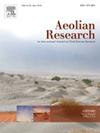青藏高原黄土的发光测年与沉积模式
IF 3.4
3区 地球科学
Q2 GEOGRAPHY, PHYSICAL
引用次数: 0
摘要
青藏高原风成沉积物是气候变化和大气环流的重要记录。前人研究认为,青藏高原内陆黄土主要在气候变暖湿润、植被覆盖增加的全新世(11.7 ka)积累,有利于沙尘的淤积,与中国黄土高原(CLP)不同。在更长时间尺度上(>11.7 ka),青藏高原黄土是否也处于暖/湿期沉积?为了回答这个问题,我们从青藏高原中部覆盖面积较大的5个风成沉积剖面中获得了23个黄土发光年龄。结果表明,黄土沉积时间约为30 ka和75 ka,对应暖湿海相同位素阶段(MIS) 3和5。而在MIS 2和MIS 4中,几乎没有发现黄土。因此,在轨道时间尺度上,青藏高原黄土主要在暖湿期积累,植被覆盖对黄土积累及其后续生态系统起关键作用。本研究为青藏高原沙尘和黄土研究提供了新的思路,为全面认识青藏高原生态系统的可持续发展提供了基础科学数据。本文章由计算机程序翻译,如有差异,请以英文原文为准。
Luminescence dating and the sedimentary pattern of loess on the Tibetan Plateau
Aeolian sediments in the Tibetan Plateau are important records for climate change and atmospheric circulation. Previous studies suggested that the interior Tibetan loess accumulated mostly in the Holocene (<11.7 ka) marked by warming and wetting climate with an increased vegetation cover, thereby facilitating dust entrapment, and that this Tibetan dust accumulation model is different from that of the Chinese Loess Plateau (CLP). In longer time scales (>11.7 ka), did Tibetan loess deposited in warm/wet period as well? To answer this question, we presented 23 loess luminescence ages from five aeolian deposit profiles in the central Tibetan Plateau covering a large area. The results demonstrate loess deposition at around 30 ka and 75 ka, corresponding to warm and wet marine isotope stage (MIS) 3 and 5. In contrast, in the MIS 2 and 4, little to no loess was detected. Thus, we conclude that Tibetan loess accumulated mainly during warm/wet periods in the orbital time scale, and vegetation cover played a key role on loess accumulation and subsequent ecological system. This study sheds light on the Tibetan Plateau dust and loess research, and further provides basic scientific data for comprehensive understanding of the TP ecosystem for sustainable development.
求助全文
通过发布文献求助,成功后即可免费获取论文全文。
去求助
来源期刊

Aeolian Research
GEOGRAPHY, PHYSICAL-
CiteScore
7.10
自引率
6.10%
发文量
43
审稿时长
>12 weeks
期刊介绍:
The scope of Aeolian Research includes the following topics:
• Fundamental Aeolian processes, including sand and dust entrainment, transport and deposition of sediment
• Modeling and field studies of Aeolian processes
• Instrumentation/measurement in the field and lab
• Practical applications including environmental impacts and erosion control
• Aeolian landforms, geomorphology and paleoenvironments
• Dust-atmosphere/cloud interactions.
 求助内容:
求助内容: 应助结果提醒方式:
应助结果提醒方式:


